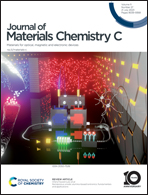Atomistic modeling of metal–ligand chirality transfer and chiroptical properties of lead and tin hybrid perovskites†
Abstract
Hybrid organic–inorganic perovskites have emerged as excellent materials for solar cell applications. Indeed, their extreme tunability and facile synthesis have opened the door to many new applications. Chiral hybrid perovskites are attracting great interest as promising chiroptoelectronic systems with potential for employment in optoelectronics, spintronics, and other applications. To date, the mechanism through which a chiral bias is generated from a chiral organic ligand to an inorganic lattice has remained unclear. Herein, we present a bespoke simulation workflow based on DFT and TD-DFT for studying the chiroptical response of lead- and tin-based 2D chiral perovskites, namely 2D R- and S-(MBA+)2PbI4 and R- and S-(MBA+)2SnI4. The most impacting factors influencing their CD signals were explored through ab initio molecular dynamics simulations and the analysis of the density of electronic states (DOSs) showing that the relevant chiroptical features are associated with a chirality transfer event driven by a metal–ligand overlap of electronic levels. This effect is more evident for tin-based chiral perovskites showing higher chirality with excitonic coupling, starting from the chiral ligands propagating within the inorganic layer. The difference between tin and lead is due to the higher mixing of metal–ligand electronic states of the tin chiral perovskite, inducing chiroptical signals with wavelengths in the range of 350–500 nm. These signals are red-shifted within the range of 500–600 nm for the lead chiral perovskite. The high electronic coupling between the chiral ligands and the tin octahedra can be ascribed to the radically different assembling of the chiral ligands encapsulated in the tin perovskite, resulting in a highly distorted coordination forming CH–π interactions with a distance value of 3.2 Å, not formed in a lead-based system.

- This article is part of the themed collection: Circularly Polarised Luminescence


 Please wait while we load your content...
Please wait while we load your content...